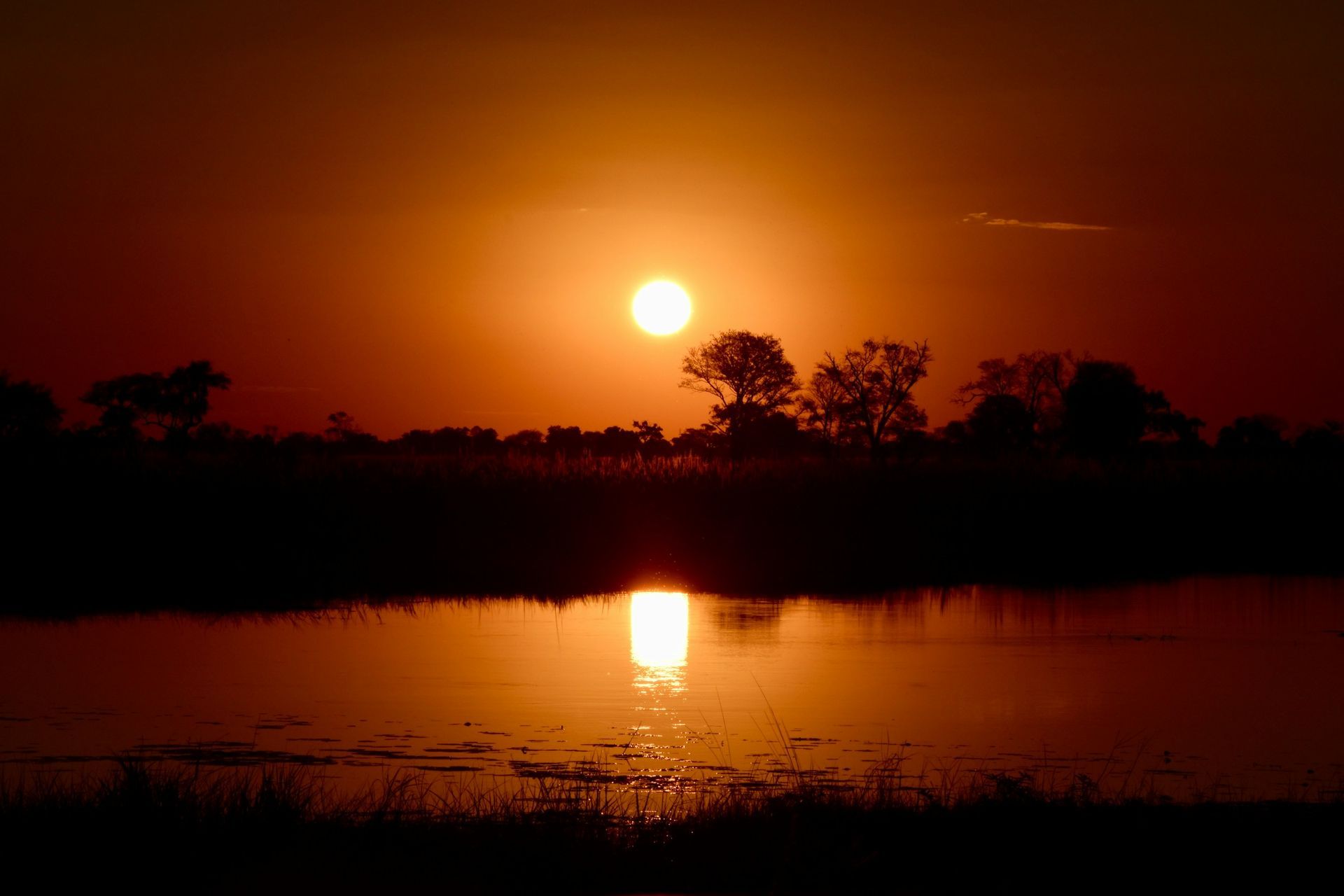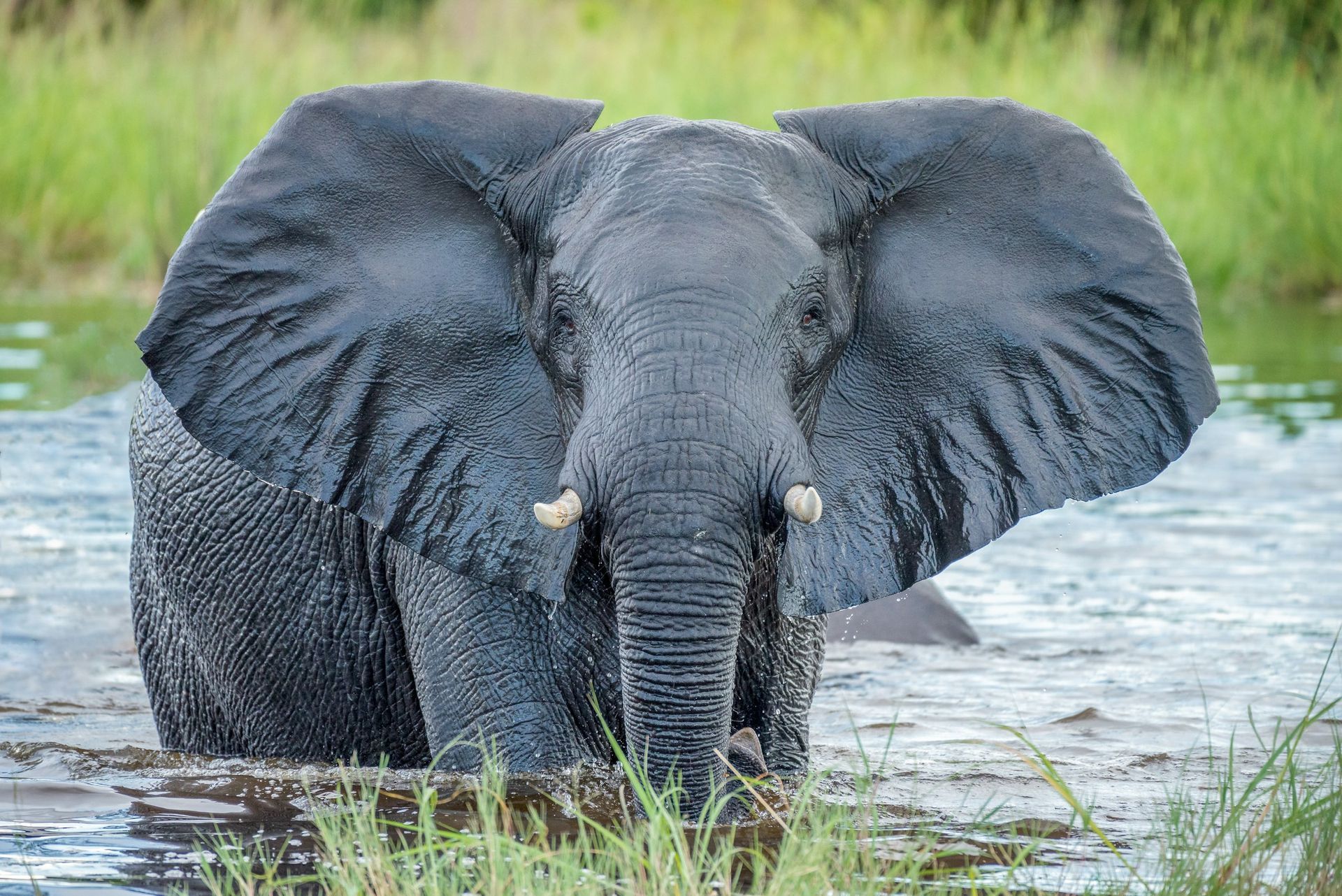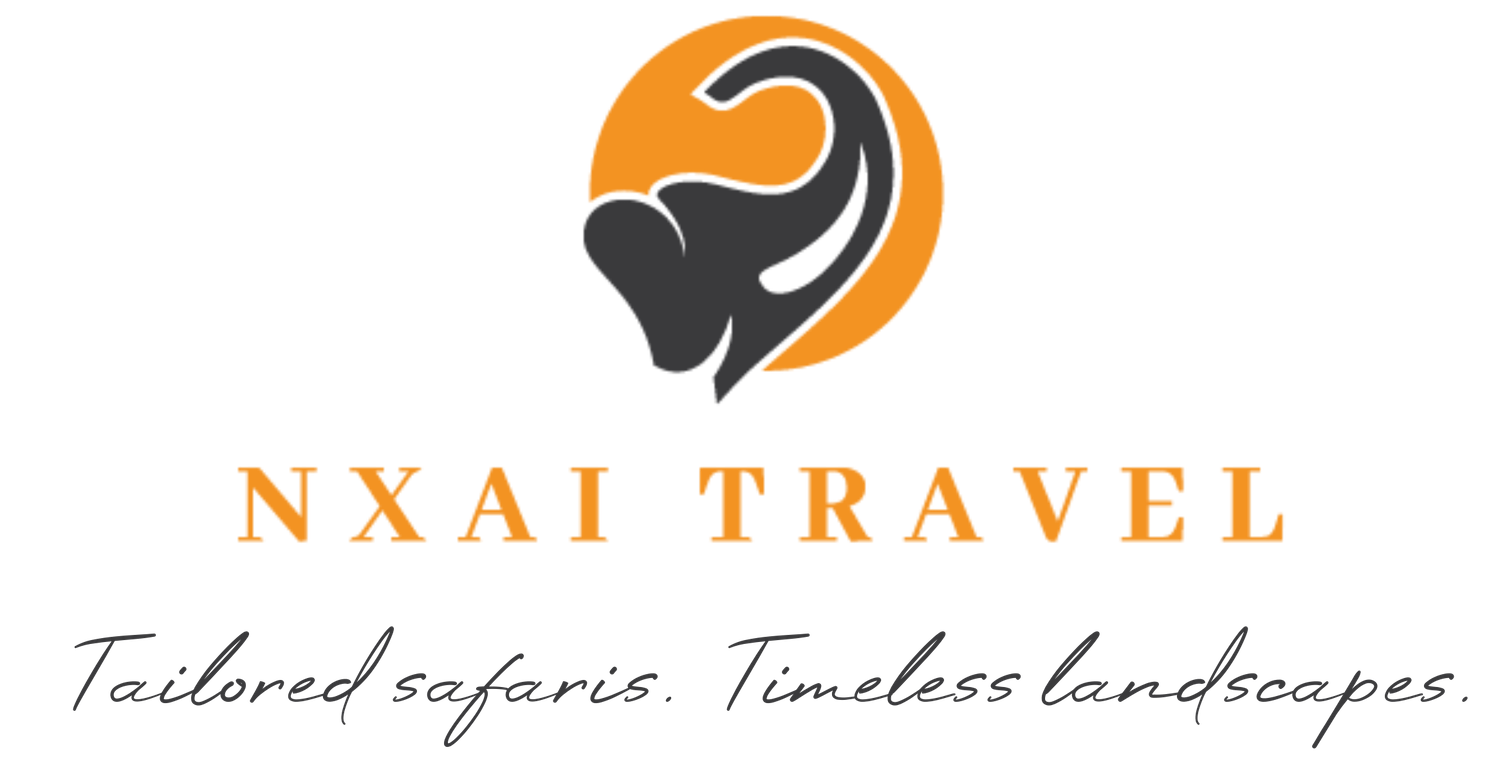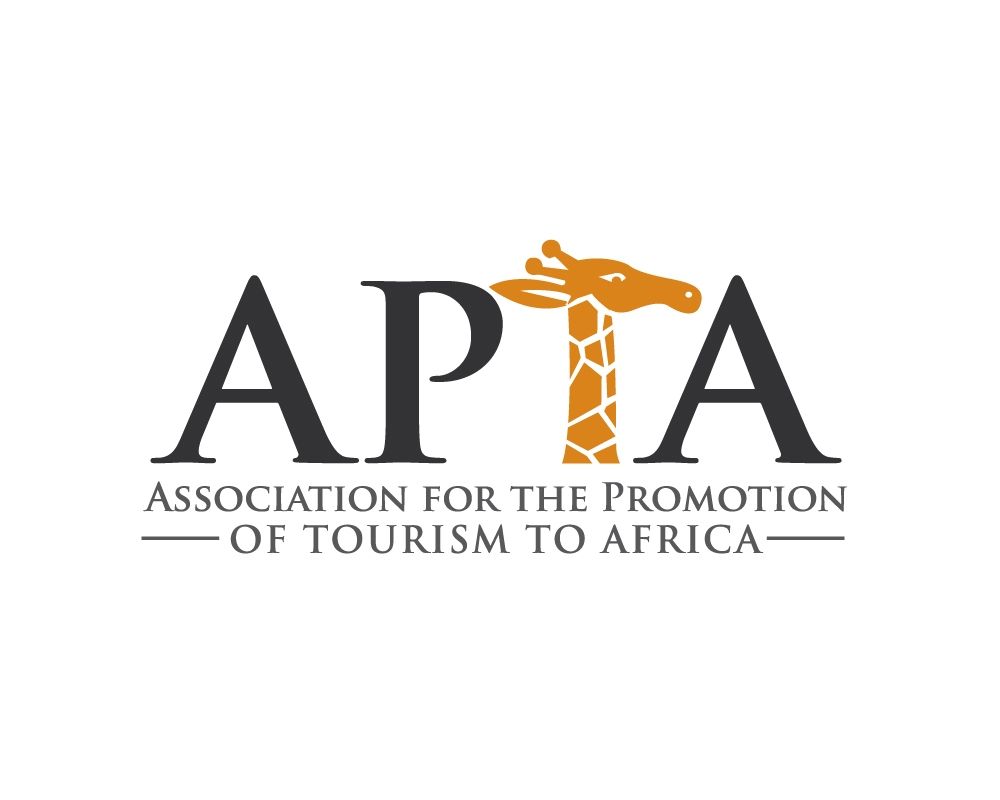Okavango Delta
& Panhandle
Okavango Delta
& Panhandle
Okavango Delta
& Panhandle
Explore one of Africa’s natural wonders
The Okavango Delta is the largest intact inland delta in the world and a designated UNESCO World Heritage Site. This vast wetland system spans over 15,000 square kilometres and contains more than 150,000 islands. It is a remarkable oasis in the middle of the Kalahari Desert – the largest continuous stretch of sand on Earth.
Each year, between June and July, floodwaters from the Angolan highlands arrive in the delta, causing it to swell to nearly three times its normal dry-season size. This annual pulse transforms the landscape, creating a rich and fragile ecosystem that sustains a remarkable variety of wildlife adapted to the contrasting conditions of desert and floodplain.
In 2013, the Okavango Delta was named one of the Seven Natural Wonders of Africa – a testament to its ecological significance and breathtaking beauty. The floodwaters shape everything here. They determine where the animals move, where birds breed, and when the land awakens in a dazzling display of seasonal abundance. From elephants and buffalo to rare African wild dogs and hundreds of bird species, the delta’s waters and islands offer sanctuary throughout the year.
Why they stand out
The Okavango Delta and Panhandle aren't just landscapes – they're living systems, fed by rainfall thousands of kilometres away. They are home to some of the most exclusive and pristine safari experiences in Africa, many within private concessions that limit vehicle numbers and ensure true immersion in the wilderness.
The delta encompasses Moremi Game Reserve, Khwai Community Concession and several surrounding private reserves, each committed to conservation and community-based tourism. The region is carefully managed to maintain its ecological integrity and cultural importance. Low-impact tourism, expert guiding and a deep respect for this fragile environment define every experience here.
For those who want to feel part of something vast and timeless – something truly wild – the Okavango and Panhandle offer a safari like no other.
Why they stand out
The Okavango Delta and Panhandle aren't just landscapes – they're living systems, fed by rainfall thousands of kilometres away. They are home to some of the most exclusive and pristine safari experiences in Africa, many within private concessions that limit vehicle numbers and ensure true immersion in the wilderness.
The delta encompasses Moremi Game Reserve, Khwai Community Concession and several surrounding private reserves, each committed to conservation and community-based tourism. The region is carefully managed to maintain its ecological integrity and cultural importance. Low-impact tourism, expert guiding and a deep respect for this fragile environment define every experience here.
For those who want to feel part of something vast and timeless – something truly wild – the Okavango and Panhandle offer a safari like no other.
Why they stand out
The Okavango Delta and Panhandle aren't just landscapes – they're living systems, fed by rainfall thousands of kilometres away. They are home to some of the most exclusive and pristine safari experiences in Africa, many within private concessions that limit vehicle numbers and ensure true immersion in the wilderness.
The delta encompasses Moremi Game Reserve, Khwai Community Concession and several surrounding private reserves, each committed to conservation and community-based tourism. The region is carefully managed to maintain its ecological integrity and cultural importance. Low-impact tourism, expert guiding and a deep respect for this fragile environment define every experience here.
For those who want to feel part of something vast and timeless – something truly wild – the Okavango and Panhandle offer a safari like no other.
Some background
The Okavango Delta owes its very existence to the slow, ancient geological uplift of the East African Rift Valley. Instead of flowing into the sea, the Okavango River is captured by fault lines in the Kalahari sands, fanning out into a maze of lagoons, channels and floodplains. This complex network changes constantly – islands appear and disappear, water levels rise and fall, and animal movements shift with the seasons.
For centuries, the delta has been home to Indigenous communities including the BaYei, Banoka and San people, who have shaped and been shaped by this land. The BaYei introduced the mokoro – a traditional dugout canoe – which remains one of the most iconic ways to experience the delta today. The Khwai community continues to protect their concession with sustainable tourism and benefit-sharing, ensuring that conservation is tied directly to local livelihoods.
In recent decades, the Okavango has become a beacon for conservation. Efforts to safeguard its biodiversity include international partnerships, research programmes, and the designation of large areas as protected land. Yet at its heart, the delta remains a wild, unpredictable system – one of the last truly untouched ecosystems on the planet.
Some background
The Okavango Delta owes its very existence to the slow, ancient geological uplift of the East African Rift Valley. Instead of flowing into the sea, the Okavango River is captured by fault lines in the Kalahari sands, fanning out into a maze of lagoons, channels and floodplains. This complex network changes constantly – islands appear and disappear, water levels rise and fall, and animal movements shift with the seasons.
For centuries, the delta has been home to Indigenous communities including the BaYei, Banoka and San people, who have shaped and been shaped by this land. The BaYei introduced the mokoro – a traditional dugout canoe – which remains one of the most iconic ways to experience the delta today. The Khwai community continues to protect their concession with sustainable tourism and benefit-sharing, ensuring that conservation is tied directly to local livelihoods.
In recent decades, the Okavango has become a beacon for conservation. Efforts to safeguard its biodiversity include international partnerships, research programmes, and the designation of large areas as protected land. Yet at its heart, the delta remains a wild, unpredictable system – one of the last truly untouched ecosystems on the planet.
Some background
The Okavango Delta owes its very existence to the slow, ancient geological uplift of the East African Rift Valley. Instead of flowing into the sea, the Okavango River is captured by fault lines in the Kalahari sands, fanning out into a maze of lagoons, channels and floodplains. This complex network changes constantly – islands appear and disappear, water levels rise and fall, and animal movements shift with the seasons.
For centuries, the delta has been home to Indigenous communities including the BaYei, Banoka and San people, who have shaped and been shaped by this land. The BaYei introduced the mokoro – a traditional dugout canoe – which remains one of the most iconic ways to experience the delta today. The Khwai community continues to protect their concession with sustainable tourism and benefit-sharing, ensuring that conservation is tied directly to local livelihoods.
In recent decades, the Okavango has become a beacon for conservation. Efforts to safeguard its biodiversity include international partnerships, research programmes, and the designation of large areas as protected land. Yet at its heart, the delta remains a wild, unpredictable system – one of the last truly untouched ecosystems on the planet.
The Okavango Delta
At the core of Botswana’s wilderness, the Okavango Delta unfolds as a vast and shifting mosaic of channels, grasslands and palm-dotted islands. It is a land where hippos glide silently beneath the water’s surface, where lechwe race through the shallows, and where lions lounge on termite mounds, surveying the floodplains.
Predators thrive here thanks to the abundance of prey. You might follow a leopard’s tracks along the edge of a lagoon, or come across wild dogs hunting at dawn. Elephants move between water and woodland in great numbers, their movements etched into the soft Kalahari sands.
Birding is exceptional year-round, with seasonal visitors adding to an already rich list. African jacanas step daintily over water lilies. Fish eagles call from the treetops. Heronries fill with life during the breeding season. The changing light – from the misty glow of morning to the burnished hues of sunset – turns every scene into something unforgettable.

The Okavango Delta
At the core of Botswana’s wilderness, the Okavango Delta unfolds as a vast and shifting mosaic of channels, grasslands and palm-dotted islands. It is a land where hippos glide silently beneath the water’s surface, where lechwe race through the shallows, and where lions lounge on termite mounds, surveying the floodplains.
Predators thrive here thanks to the abundance of prey. You might follow a leopard’s tracks along the edge of a lagoon, or come across wild dogs hunting at dawn. Elephants move between water and woodland in great numbers, their movements etched into the soft Kalahari sands.
Birding is exceptional year-round, with seasonal visitors adding to an already rich list. African jacanas step daintily over water lilies. Fish eagles call from the treetops. Heronries fill with life during the breeding season. The changing light – from the misty glow of morning to the burnished hues of sunset – turns every scene into something unforgettable.

The Okavango Delta
At the core of Botswana’s wilderness, the Okavango Delta unfolds as a vast and shifting mosaic of channels, grasslands and palm-dotted islands. It is a land where hippos glide silently beneath the water’s surface, where lechwe race through the shallows, and where lions lounge on termite mounds, surveying the floodplains.
Predators thrive here thanks to the abundance of prey. You might follow a leopard’s tracks along the edge of a lagoon, or come across wild dogs hunting at dawn. Elephants move between water and woodland in great numbers, their movements etched into the soft Kalahari sands.
Birding is exceptional year-round, with seasonal visitors adding to an already rich list. African jacanas step daintily over water lilies. Fish eagles call from the treetops. Heronries fill with life during the breeding season. The changing light – from the misty glow of morning to the burnished hues of sunset – turns every scene into something unforgettable.

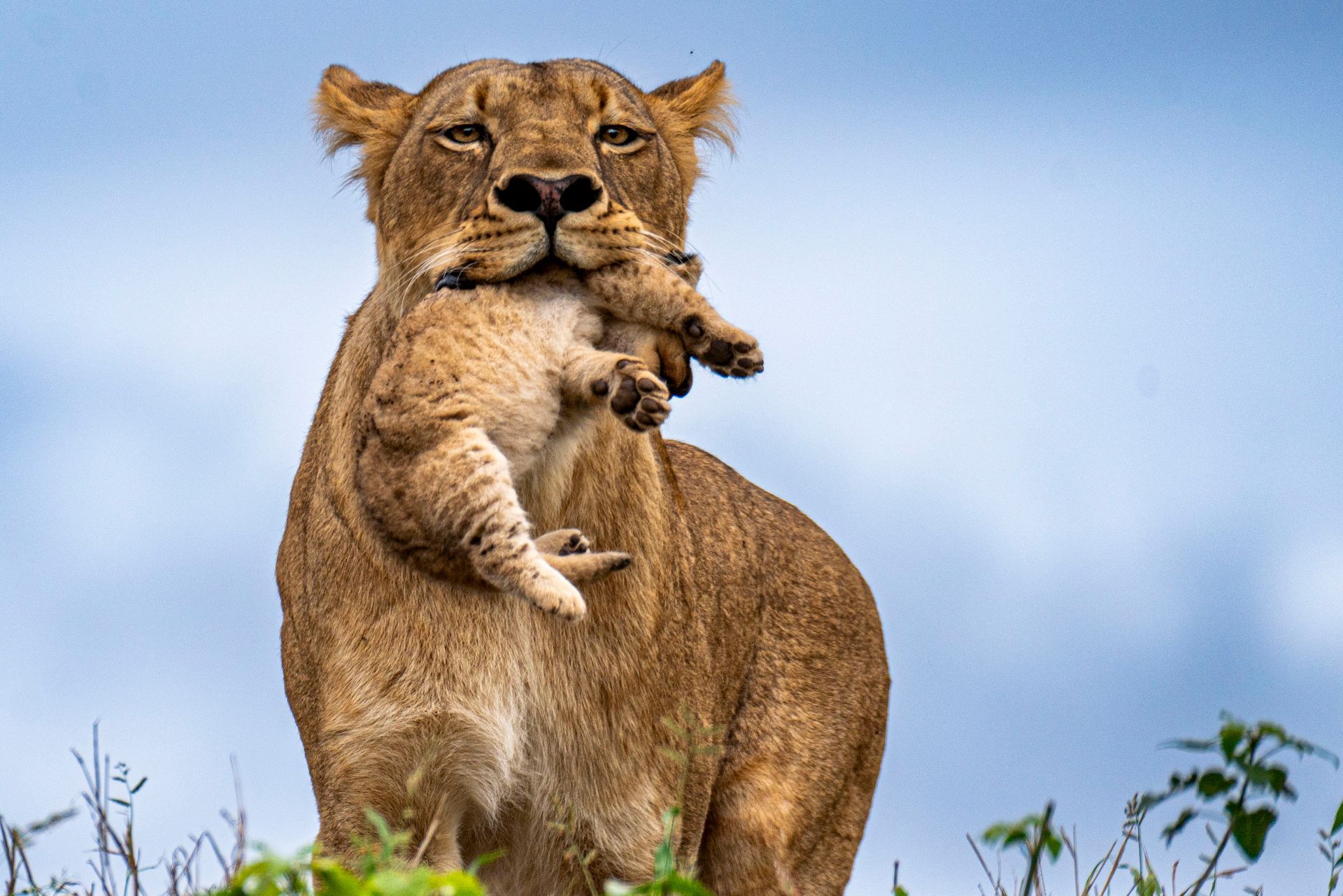
The Panhandle
Before the waters spread into the vast wetland of the delta, the Okavango River flows through a narrow ribbon of swampy floodplain known as the Panhandle. Here the river runs deep and steady, flanked by dense papyrus, riverine forest and open lagoons.
The Panhandle offers a slower, more relaxed pace of safari, ideal for birders and anglers. Hippos wallow in the shallows. Giant crocodiles bask on the banks. The river is alive with tigerfish, attracting keen fishermen during the annual barbel run in the spring months.
Nearby, the Tsodilo Hills rise suddenly from the flatness of the Kalahari – a spiritual place long revered by the San people. These ancient hills are covered in thousands of rock paintings, some over 20,000 years old, and are recognised as a UNESCO World Heritage Site. Visiting Tsodilo adds a cultural depth to the wilderness experience, connecting you with the deep human history of this land.

The Panhandle
Before the waters spread into the vast wetland of the delta, the Okavango River flows through a narrow ribbon of swampy floodplain known as the Panhandle. Here the river runs deep and steady, flanked by dense papyrus, riverine forest and open lagoons.
The Panhandle offers a slower, more relaxed pace of safari, ideal for birders and anglers. Hippos wallow in the shallows. Giant crocodiles bask on the banks. The river is alive with tigerfish, attracting keen fishermen during the annual barbel run in the spring months.
Nearby, the Tsodilo Hills rise suddenly from the flatness of the Kalahari – a spiritual place long revered by the San people. These ancient hills are covered in thousands of rock paintings, some over 20,000 years old, and are recognised as a UNESCO World Heritage Site. Visiting Tsodilo adds a cultural depth to the wilderness experience, connecting you with the deep human history of this land.

The Panhandle
Before the waters spread into the vast wetland of the delta, the Okavango River flows through a narrow ribbon of swampy floodplain known as the Panhandle. Here the river runs deep and steady, flanked by dense papyrus, riverine forest and open lagoons.
The Panhandle offers a slower, more relaxed pace of safari, ideal for birders and anglers. Hippos wallow in the shallows. Giant crocodiles bask on the banks. The river is alive with tigerfish, attracting keen fishermen during the annual barbel run in the spring months.
Nearby, the Tsodilo Hills rise suddenly from the flatness of the Kalahari – a spiritual place long revered by the San people. These ancient hills are covered in thousands of rock paintings, some over 20,000 years old, and are recognised as a UNESCO World Heritage Site. Visiting Tsodilo adds a cultural depth to the wilderness experience, connecting you with the deep human history of this land.
What kind of safari to expect
The Okavango offers a safari unlike any other in Africa. Here, the emphasis is not on chasing sightings, but on entering the rhythm of the landscape. Whether by mokoro, on foot, or in an open safari vehicle, the pace is unhurried and immersive.
In the wetter parts of the delta, water-based safaris dominate. A mokoro ride through the lily-covered channels is slow, silent and completely absorbing – a way to move with the land, not over it. These excursions reveal hidden wonders: tiny painted reed frogs, the bright flash of a malachite kingfisher, the soft rustle of reeds as an elephant feeds nearby.
On drier islands and floodplains, open vehicle safaris take you into big game territory. Guides know every bend of the track and every sign in the sand. Morning drives often bring thrilling predator sightings, while afternoon outings end with golden light and cold sundowners beside the water.
Walking safaris are also possible in certain concessions, offering a deep, sensory experience of the bush. Here it’s not just about the big game – it’s about the scent of wild sage, the tracks of mongoose at a den, the echo of hornbills calling in the canopy.
In the Panhandle, life flows at river pace. Boat cruises offer up-close views of crocodiles, hippos and waterbirds. Fishing excursions target the elusive tigerfish. And further inland, guided visits to Tsodilo Hills reveal stories etched into stone and spirit.
What kind of safari to expect
The Okavango offers a safari unlike any other in Africa. Here, the emphasis is not on chasing sightings, but on entering the rhythm of the landscape. Whether by mokoro, on foot, or in an open safari vehicle, the pace is unhurried and immersive.
In the wetter parts of the delta, water-based safaris dominate. A mokoro ride through the lily-covered channels is slow, silent and completely absorbing – a way to move with the land, not over it. These excursions reveal hidden wonders: tiny painted reed frogs, the bright flash of a malachite kingfisher, the soft rustle of reeds as an elephant feeds nearby.
On drier islands and floodplains, open vehicle safaris take you into big game territory. Guides know every bend of the track and every sign in the sand. Morning drives often bring thrilling predator sightings, while afternoon outings end with golden light and cold sundowners beside the water.
Walking safaris are also possible in certain concessions, offering a deep, sensory experience of the bush. Here it’s not just about the big game – it’s about the scent of wild sage, the tracks of mongoose at a den, the echo of hornbills calling in the canopy.
In the Panhandle, life flows at river pace. Boat cruises offer up-close views of crocodiles, hippos and waterbirds. Fishing excursions target the elusive tigerfish. And further inland, guided visits to Tsodilo Hills reveal stories etched into stone and spirit.
What kind of safari to expect
The Okavango offers a safari unlike any other in Africa. Here, the emphasis is not on chasing sightings, but on entering the rhythm of the landscape. Whether by mokoro, on foot, or in an open safari vehicle, the pace is unhurried and immersive.
In the wetter parts of the delta, water-based safaris dominate. A mokoro ride through the lily-covered channels is slow, silent and completely absorbing – a way to move with the land, not over it. These excursions reveal hidden wonders: tiny painted reed frogs, the bright flash of a malachite kingfisher, the soft rustle of reeds as an elephant feeds nearby.
On drier islands and floodplains, open vehicle safaris take you into big game territory. Guides know every bend of the track and every sign in the sand. Morning drives often bring thrilling predator sightings, while afternoon outings end with golden light and cold sundowners beside the water.
Walking safaris are also possible in certain concessions, offering a deep, sensory experience of the bush. Here it’s not just about the big game – it’s about the scent of wild sage, the tracks of mongoose at a den, the echo of hornbills calling in the canopy.
In the Panhandle, life flows at river pace. Boat cruises offer up-close views of crocodiles, hippos and waterbirds. Fishing excursions target the elusive tigerfish. And further inland, guided visits to Tsodilo Hills reveal stories etched into stone and spirit.
Things to do and see
The Okavango Delta and Panhandle offer an array of activities to suit every kind of safari traveller. Lodges located on permanent water focus on mokoro excursions and boat trips, while those on dry islands offer open safari vehicle game drives. Many combine both, allowing for a varied and balanced experience of land and water.
Walking safaris, birding excursions and night drives deepen the experience further, revealing the quieter side of the bush. The clear, unpolluted skies over the delta make stargazing especially rewarding. Helicopter flips reveal the sheer scale of the wetland, while village visits offer meaningful insight into the culture and traditions of the people who call this landscape home.
For the adventurous, horse safaris and catch-and-release fishing provide even more ways to engage with this incredible environment.
Things to do and see
The Okavango Delta and Panhandle offer an array of activities to suit every kind of safari traveller. Lodges located on permanent water focus on mokoro excursions and boat trips, while those on dry islands offer open safari vehicle game drives. Many combine both, allowing for a varied and balanced experience of land and water.
Walking safaris, birding excursions and night drives deepen the experience further, revealing the quieter side of the bush. The clear, unpolluted skies over the delta make stargazing especially rewarding. Helicopter flips reveal the sheer scale of the wetland, while village visits offer meaningful insight into the culture and traditions of the people who call this landscape home.
For the adventurous, horse safaris and catch-and-release fishing provide even more ways to engage with this incredible environment.
Things to do and see
The Okavango Delta and Panhandle offer an array of activities to suit every kind of safari traveller. Lodges located on permanent water focus on mokoro excursions and boat trips, while those on dry islands offer open safari vehicle game drives. Many combine both, allowing for a varied and balanced experience of land and water.
Walking safaris, birding excursions and night drives deepen the experience further, revealing the quieter side of the bush. The clear, unpolluted skies over the delta make stargazing especially rewarding. Helicopter flips reveal the sheer scale of the wetland, while village visits offer meaningful insight into the culture and traditions of the people who call this landscape home.
For the adventurous, horse safaris and catch-and-release fishing provide even more ways to engage with this incredible environment.
Why choose the Okavango Delta
and Panhandle
The Okavango Delta is not only one of the most spectacular natural wonders of Africa – it is also one of the most rewarding and multifaceted safari destinations in the world. From its seasonal floods to its complex ecosystems, its cultural depth to its extraordinary wildlife, it offers something rare and deeply moving.
Here, you are not just watching nature – you are part of it. Whether gliding silently in a mokoro, tracking wild dogs across the floodplains, casting a line in the Panhandle, or standing beneath the ancient art of Tsodilo Hills, this is a place that speaks to the soul.
For those seeking an authentic, varied and deeply enriching safari, the Okavango Delta and Panhandle offer a journey you will never forget.
Why choose the Okavango Delta
and Panhandle
The Okavango Delta is not only one of the most spectacular natural wonders of Africa – it is also one of the most rewarding and multifaceted safari destinations in the world. From its seasonal floods to its complex ecosystems, its cultural depth to its extraordinary wildlife, it offers something rare and deeply moving.
Here, you are not just watching nature – you are part of it. Whether gliding silently in a mokoro, tracking wild dogs across the floodplains, casting a line in the Panhandle, or standing beneath the ancient art of Tsodilo Hills, this is a place that speaks to the soul.
For those seeking an authentic, varied and deeply enriching safari, the Okavango Delta and Panhandle offer a journey you will never forget.
Why choose the Okavango Delta
and Panhandle
The Okavango Delta is not only one of the most spectacular natural wonders of Africa – it is also one of the most rewarding and multifaceted safari destinations in the world. From its seasonal floods to its complex ecosystems, its cultural depth to its extraordinary wildlife, it offers something rare and deeply moving.
Here, you are not just watching nature – you are part of it. Whether gliding silently in a mokoro, tracking wild dogs across the floodplains, casting a line in the Panhandle, or standing beneath the ancient art of Tsodilo Hills, this is a place that speaks to the soul.
For those seeking an authentic, varied and deeply enriching safari, the Okavango Delta and Panhandle offer a journey you will never forget.


